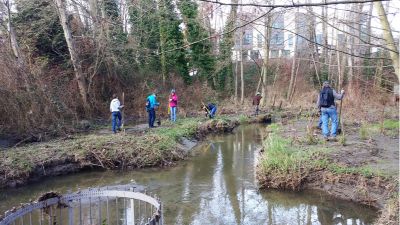The Legacy Trail
If you happen to be taking a stroll down the Longfellow Creek Legacy Trail in West Seattle, you may be surprised by the diversity of habitats you find yourself in. One moment you will be enjoying a shaded forest next to a meandering creek, and the next you will be within an artistic rendering of a salmon back bone! For those not familiar with the 4.2-mile Legacy Trail, it was completed as a volunteer-supported project in 2004. The trail was built not only to highlight the importance of Longfellow Creek, but to connect community members to parks, greenspaces, and restored natural areas.
Longfellow Creek is a 3.5-mile long tributary of the Duwamish River, and one of only two tributaries that still support spawning salmon. Starting from its headwaters at Roxhill Bog, the creek flows through the urban neighborhoods of Roxhill, Delridge, and West Seattle until it exits into the Duwamish River.
Changes to Longfellow Creek
It is an understatement to say that Longfellow Creek has changed in the last 200 years. Before Euro-American settlement, the surrounding forests were extremely dense and moist, with old-growth trees surrounding the creek, and free of invasive plants. The indigenous tribes that lived in the area near the creek referred to it as t7áWee (to-AH-wee). Translated, t7áWee means “smelt,” suggesting that this waterway was used as a traditional fishery for the indigenous tribes of the area, and was likely teeming with fish. However, the creek started to undergo drastic changes by the mid-1800s due to farming, timber harvesting, and settlement in the surrounding area.
The impact of this logging is still felt throughout natural areas within Seattle. Old-growth forests are virtually nonexistent around streams and that has led to the establishment of invasive plants such as Japanese knotweed, jewelweed, reed canary grass, and many more. These plants can overwhelm a creek and out-compete native vegetation. In addition, due to the urban development of West Seattle, approximately one-third of Longfellow Creek has been rerouted through pipes, and now travels under shopping centers, houses, and roads! These changes have had serious repercussions for the water quality and salmon habitat in the creek.
Spawning Salmon in Longfellow
There are indeed salmon in Longfellow Creek, and the presence of the coho salmon run has driven much of the restoration and research work within Longfellow Creek. Seattle-based organization Puget Soundkeeper has been performing pre-spawn mortality surveys with volunteers for years to document how stormwater runoff influences spawning success. They have reported that 45%-90% of female coho salmon in the creek die before they have a chance to spawn. This is largely due to poor water quality attributed to stormwater runoff; this can be particularly hard on coho salmon who migrate up Longfellow Creek in the fall when pollutants have built up all summer and are flushed into the creek by the first rainfall events.
Saving Salmon and Restoring Forests
Despite the challenges Longfellow Creek faces, there is still hope! Through the efforts of the Green Seattle Partnership and volunteer organizations, forests around the creek and in the watershed are being restored by removing invasive plants and planting native species. DNDA–Nature Consortium has also recently acquired and is in the process of restoring a wetland in Delridge that will help mitigate stormwater runoff before it enters Longfellow Creek, which will benefit the coho that spawn there.
In addition to the organizations working within the watershed to restore vital green spaces, Seattle Public Utilities (SPU) and the Seattle Department of Transportation have recently rolled out the Longfellow Creek Natural Drainage System (NDS) Project. This is an exciting construction project that has been designed with the intention to promote a healthier creek ecosystem by installing “planter strips filled with deep-rooted plants and spongy soils that temporarily hold and clean polluted stormwater.”
What Can You Do?
As a community member there is so much that you can do to make our waterways healthier! Volunteering your time at a restoration event along Longfellow Creek or within the watershed is a fun and impactful way to help restore Longfellow Creek. The City of Seattle also has a list of ways we can all help keep our waterways safe by preventing pollution at its source. These preventative measures will go a long way in improving water quality and reducing Salmon mortality.





Thanks for the informative article on a stream in my backyard. I learned a lot and hope to find some time to volunteer in the near future. Keep up the good work!